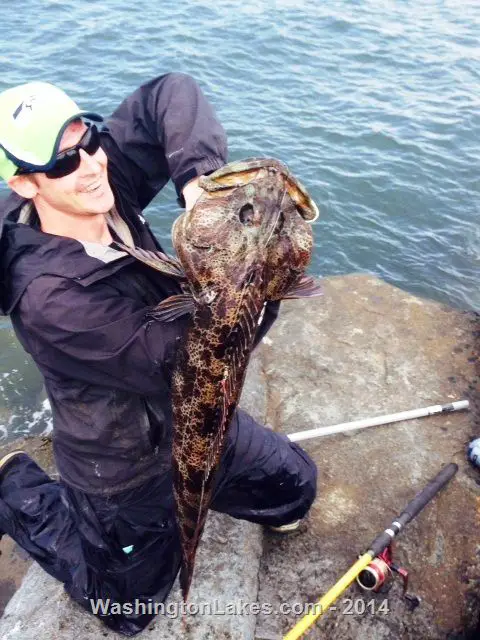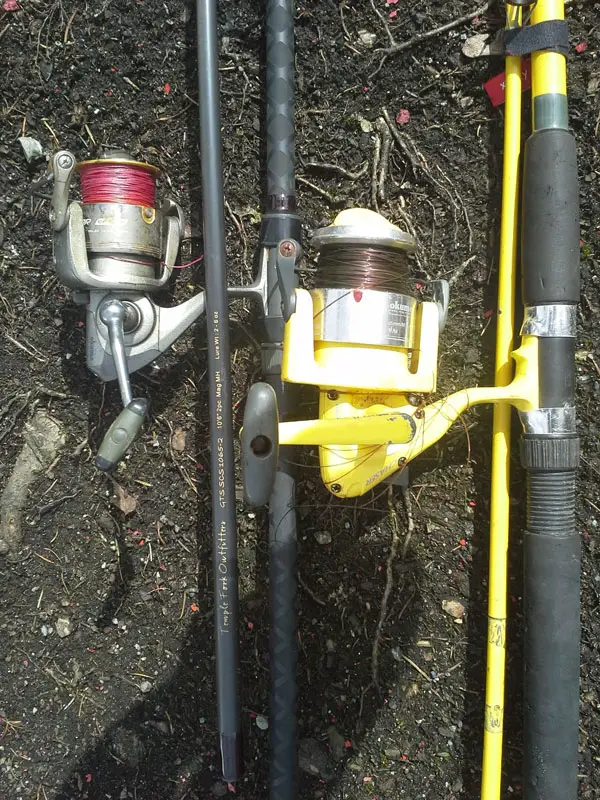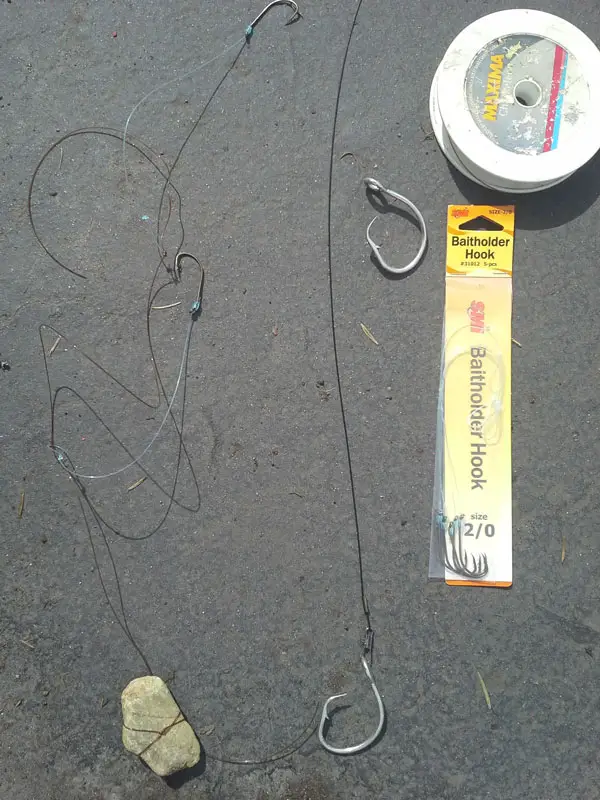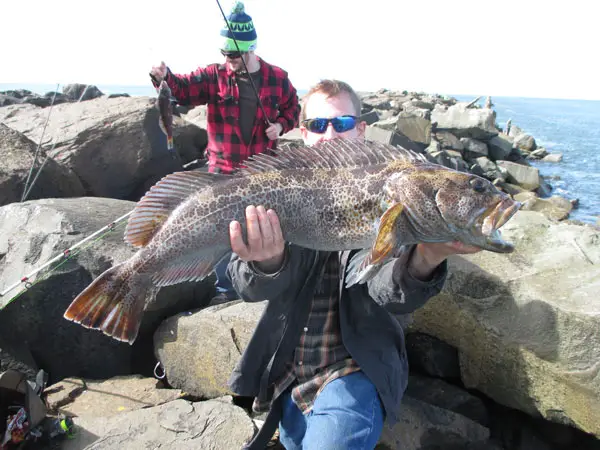Search
Latest Articles
Westport Jetty Lings
by Nate Treat, March 27, 2015
All of the sudden, during a drop on an aggressive lift of the jig something grabbed hold of the end of my line. It pulled hard enough to pull my small, four foot frame off the rock I had been sitting on, nearly ripping the rod out of my hand it a tremendous amount of power and I ended up knee deep in the surf as I slid down barnacle covered rocks that ripped a hole in my jeans. Five seconds later after a few more giant head shakes my line went slack, my rod straightened out with a snap and I reeled in an empty line. The 20 lbs. monofilament line was shredded in the last foot of line, torn to bits by some unknown toothy sea creature.
That day gave me an itch, which quickly became an obsession. I wanted to catch a ling cod.
It took us what seemed like years to figure it out. This was in the days before the internet, books at the library were how we learned. Magazines that we subscribed to like Outdoor Life and Field and Stream were all about bass in the south, or redfish and tarpon in the east, Rocky Mountain rainbows on the dry fly. There wasn’t a lot of information on jetty fishing available. We poured over my grandfather’s fishing journal, and salivated over the entries where he had caught a 12 and 5 pound ling cod, a mess of surf perch.
Long story short, we were determined to crack the mystery of jetty lings, and although it took us several seasons, we finally did. We created a system that became a reliable and inexpensive method to hook lings on every trip. Many of you are in the same boat as we were, and I’m here to help you. After much trial and error, this is my system to catch ling cod from the jetty.
The process:
Ling cod on the Westport jetty are munching on kelp greenling, or “kelpies” as we call them. This is their favorite snack. So to catch lings, we first have to catch greenling. Greenling love shrimp. Sand shrimp. So you have to dig your sand shrimp first.
The gear:
1. 2 long, stout rods. One for bait, the other for ling cod. They don’t need to be fancy. The length keeps your line up off the rocks, and the stoutness allows you to cast out greenling and heavy weights without snapping your rod. The rocks on the jetty are hard on your gear, so the more inexpensive you can go the better.
2. A reel big enough to hold a decent amount of 40 lbs. mono. I picked mine up used at a pawn shop for ten bucks. It’s a beast, and it gets the job done. It shows the battle scare of rubbing up on rocks, and has lasted me more than a decade of countless hikes on the jetty.
3. 40 to 50 pound monofilament. I’ve used the same spool of Maxima Ultragreen for years. The abrasion resistance is superb, and the strength is ideal for the way that you’re going to rig up your bait.
4. Optionally, for your ling rod you can run braided line. On my ling reel, I have 100 lbs. Power Pro. I’ve used the same spool of line since I bought it more than a decade ago. It doesn’t break. I lasts forever.
5. A handful of snelled bait holder hooks. I prefer 1/0 to 2/0 hooks. They come prettied, the larger ones are tied with 15 to 20 pound line, perfect for bait fish. The larger hooks hold onto your sand shrimp, while still being small enough to hook the small mouths of a greenling. The heavier line they tie them with will also be a boon if you happen to hook a big toothy cabezon or ling.
6. Steel leaders. 40-50 pound is sufficient. This solves the problem of the ling cod’s teeth. They have more teeth than a musky, and can easily bite right through 50 lbs. mono.
7. Big hooks. We use 15/0 Gamakatsu circle hooks. They need to have a big enough gap to hook a greenling through the back. Keep them sharp, snap those on the end of a steel leader and you’re good to go.
8. A long handled net. We have an extension on ours so it’s about 10 feet long. This allows you to net the fish from high up on the rocks without getting wet. It should be large enough to fit a ling cod in it.
9. A bucket of jetty rocks for weight.
Pumping shrimp:
You’re going to time your trip around the low tide. Ideally, you’ll catch a low tide first thing in the morning, pump your sand shrimp and then head out to the jetty afterwards. Pumping shrimp is easy. You can either use either a clam gun, or a custom made shrimp pump, both of which are available at our local sporting goods stores, or online at various retailers. The tide flats around the bays are the best places to dig shrimp, they show just like clams, and on a good day you’ll be able to pump limits in 15 minutes. It is much cheaper than buying them in the store, where a carton of shrimp will set you back anywhere from 3 to 5 dollars, and that is when you can find them. You will go through a ton of bait too, so that can get expensive really fast. But believe me, you will catch 10 times more greenling, perch and sea bass with sand shrimp over any other bait. You use the small greenling as bait, and take the big ones home for delicious fillets.
Catching the greenling:
We use a regular old drop shot style bottom fish rig. 2 or 3 bait holder hooks, with a weight down below to hold the bottom. We quickly found out that 4 ounce lead gets expensive, at a buck a weight, you’re going to donate a LOT of lead to the bottom. You will get snagged.
Tie on your bait holder snells with an overhand knot, spaced about a foot and a half to two feet apart. The heavy mainline makes these knots more than sufficiently strong to pull in big fish without breaking.
To save money, we use rocks. Tie ‘em on like a present, with square knots. The best rocks are angular, longer and square so that it is easy to tie your rock on.
That’s it! Greenling are going to be right up close to the rocks. You don’t need to cast more than 20 feet out, let it sink to the bottom, let your weight sit until you hook a fish. The trick to avoiding getting
snagged on the rocks is to leave your rock on the bottom. Don’t move it around, otherwise it will fall into a crevice and your rock is gone. Use a rock heavy enough to hold bottom against the current, but small enough to cast. The larger profile of a rock keeps your weight out of the smaller cracks, so you won’t get snagged near as much as if you were using a more compact lead pyramid or bank sinker.
When you’re using sand shrimp, you’re going to catch a bunch of greenling in short order. They munch those shrimp like they’re at the all you can eat seafood buffet at the casino. As soon as you catch a greenling, hook it onto your ling rod, stabbing it through the back, and toss it back out there.
You don’t need any weight or other tackle. The greenling will swim down to the bottom. Let it swim. Every once in a while, lift up on it to keep it out of the rocks. The greenling will struggle, swim back down and look exactly like what it is: an injured bait fish just waiting to be munched on by a giant ling.
Now this is the most important part: When a ling hits, DON’T SET THE HOOK. Circle hooks are engineered so that the fish hooks itself. Let the ling eat it. The first big pull is pretty darn exciting. The ling is grabbing the bait, and chomping it, trying to get the bait head first so he can swallow it whole. Wait until he really pulls on it. You’ll know when it’s time. It takes a lot of patience to wait, as your first instinct will be to reel like crazy, but if you do, the ling will probably spit the bait. When he pulls hard, that means he’s got a good grasp on the bait, and he’s liable to hook himself in the corner of the mouth.
Use a steady lift, drop, reel to bring him in. The majority of the time the ling won’t even know that he’s hooked. They are greedy. They won’t let go. Often times you won’t even hook the ling, he will simply stubbornly hold on. This is good for you. If they figure out that they’re hooked, they will make long, powerful runs, heading straight for the rocks, and more often than not they will snag up and break off. If they don’t realize they’re hooked, they don’t fight, and you won’t get snagged.
Get ready with the net. Ideally you’re going to have a net man waiting as soon as the bite starts. He wants to keep the net in the water, waiting for the fish to show color. The most important part is that you don’t pull the ling’s head out of the water. If he isn’t hooked, he’ll realize that something is awry, and spit out the bait and run back to the rocks. Lead the ling to the net, and you’ve got a big ole fillet of fish and chips.
That’s all there is too it. The gear is inexpensive, and the method is the most effective way to reliably catch fish. Sure, there are other ways to bring in lings, but they cost an arm and a leg more and they are 10 times less effective. There have been many days where my party is the only party walking off the jetty with any lings at all. If you practice this method, I can guarantee that you will catch more lings than anyone else on the jetty. Be prepared to get snagged and break off a lot of gear, come prepared to pack out a bunch of heavy, toothy, nasty, mean looking ling cod. I look forward to seeing you out there, and hope your lines stay tight!
A note about jetty safety:
The jetty is a dangerous place. It’s not for everyone. The rocks are slippery when wet, the gaps can be big, and if you’re not very careful you can slip and fall and break your rod, or worse, an arm or a leg. Know your limits, wear grippy, soft soled tennis shoes and take your time. The jetty may not be a good place to take really young children, or someone who has a bad back or stiff joints. When the weather gets bad, the wind gets strong, waves can crash over the rocks and wash you out to sea. Know your limitations, and if it gets to be dangerous, don’t hesitate to hike out carefully.
Pumping Shrimp at start of this video
Reports of Interest:
Ling from the Jetty Report 1



